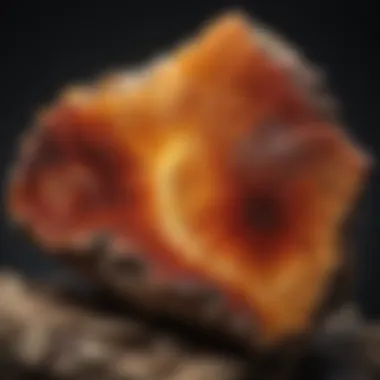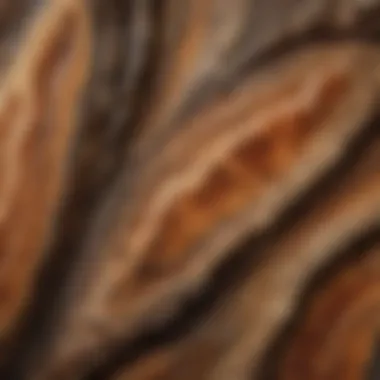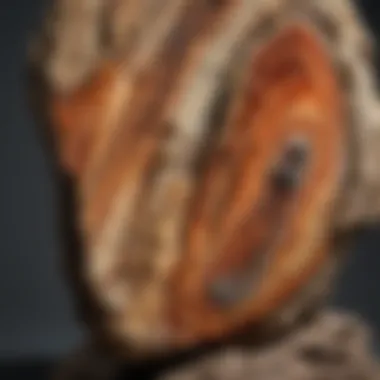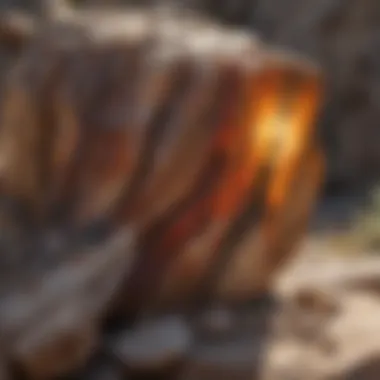Unveiling the Enigmatic Pricing of Petrified Wood: A Definitive Guide for Rock and Fossil Collectors


Rock and Fossil Identification
In the realm of rock and fossil collection, understanding the various types of rocks and fossils is paramount. Petrified wood, a fascinating specimen formed through the process of permineralization, is distinguished by its unique characteristics. Collectors should look for distinct features such as the wood's cellular structure replaced by minerals, vibrant colorations, and well-defined grain patterns. To enhance the identification process, utilizing tools like hand lenses, UV lights, and hardness testing kits can aid in accurately identifying and categorizing different types of petrified wood specimens.
Pricing Factors for Petrified Wood
When delving into the pricing of petrified wood, various factors come into play. The rarity, size, quality, and age of the specimen significantly influence its market value. Petrified wood with vibrant colors, intricate patterns, and well-preserved details often commands higher prices due to its aesthetic appeal and collectible nature. Additionally, the location and source of the wood can impact its price, with specimens from renowned sites or historical significance holding greater value in the eyes of collectors.
Evaluating Value and Quality
To accurately assess the value of petrified wood specimens, collectors must consider multiple facets. Thorough examination of the wood's color intensity, clarity of grain patterns, and overall condition is essential in determining its quality. Size and weight also play a role in pricing, with larger, denser pieces typically valued higher for their visual impact and rarity. Understanding the market trends and demand for specific types of petrified wood can further aid in evaluating the worth of a collection or individual pieces.
Tips for Building a Collection
For passionate rock and fossil collectors looking to expand their petrified wood collection, strategic acquisition and preservation techniques are key. Seeking out reputable dealers, attending trade shows, and networking with fellow enthusiasts can provide opportunities to acquire unique specimens and valuable additions to a collection. Implementing proper storage methods, such as using acid-free paper, foam padding, or display cases, ensures the longevity and preservation of prized petrified wood pieces. Creative display ideas, including mounting specimens on custom stands, shadow boxes, or wall-mounted shelves, can enhance the aesthetic appeal and showcase the beauty of petrified wood within a collector's space.
Conclusion
Exploring the price for petrified wood unveils a world of intrigue and discovery for rock and fossil enthusiasts. From understanding the intricate pricing factors to evaluating the quality and value of specimens, this comprehensive guide equips collectors with the knowledge and insights needed to navigate the market with confidence and expertise. By applying the tips and techniques outlined in this guide, collectors can enhance their collecting experience and build a vibrant petrified wood collection that reflects their passion for natural history and geology.
Introduction
In the intricate world of petrified wood pricing, understanding the factors influencing the value of these ancient treasures is paramount for rock and fossil collectors. This introduction sets the stage for a comprehensive guide that will provide enthusiasts with valuable insights and perspectives essential for navigating the market with confidence and expertise. Delving into the nuances of pricing petrified wood specimens, this guide aims to equip collectors with the necessary knowledge to make informed decisions and appreciate the true value of these unique fossils.
Overview of Petrified Wood
Formation Process of Petrified Wood:
The formation process of petrified wood is a fascinating journey where organic remains are gradually replaced by minerals, preserving the intricate cellular structures and stunning colors of the original wood. This transformation occurs over millions of years, turning once-living trees into stone-like fossils with remarkable clarity and detail. Petrified wood's formation process not only captivates collectors with its unique preservation method but also adds to the mystique and allure of these ancient relics that have stood the test of time.
Unique Characteristics:
Petrified wood boasts a myriad of unique characteristics, including vivid hues, intricate grain patterns, and the occasional presence of sparkling crystals or fossils trapped within its crystalline structure. These distinctive features make each specimen a one-of-a-kind masterpiece, garnering attention from collectors worldwide. The rarity and individuality of petrified wood's unique characteristics underscore its appeal and value, making it a coveted addition to any rock and fossil collection.
Significance of Petrified Wood
Historical Importance:
The historical importance of petrified wood dates back centuries, where ancient civilizations revered these fossilized remains for their symbolic significance and natural beauty. Used in various cultural practices and artifact creation, petrified wood has played a pivotal role in shaping the history of human civilization. Its ability to transcend time and provide insights into prehistoric environments makes petrified wood a valuable testament to our planet's ancient past.


Scientific Value:
Beyond its historical relevance, petrified wood holds significant scientific value in unraveling Earth's geological history and past ecological landscapes. Through meticulous analysis of petrified wood specimens, scientists gain crucial insights into ancient flora, climate conditions, and evolutionary processes. The scientific value of petrified wood extends far beyond mere aesthetics, enriching our understanding of the Earth's natural history and evolutionary development.
Factors Influencing Price
In the realm of petrified wood collecting, understanding the factors that influence price is paramount for enthusiasts and collectors alike. Several key elements heavily impact the value of petrified wood specimens, making it crucial to delve into these aspects. By comprehensively exploring these factors, collectors can make informed decisions when assessing the worth of different pieces.
Quality plays a significant role in determining the price of petrified wood. Factors such as coloration, texture, grain patterns, as well as the presence of cracks or inclusions, all contribute to the overall value of a specimen. Assessing these elements carefully can give collectors a deeper appreciation of the craftsmanship and uniqueness of each piece.
Moreover, size and weight also play a crucial role in price evaluation. Larger and heavier specimens often command higher prices due to their impressive visual presence and rarity. Understanding how size and weight impact pricing can assist collectors in making informed decisions when adding pieces to their collection.
Lastly, the rareness and uniqueness of a specimen heavily influence its price. Petrified wood that is limited in availability or possesses unique features can fetch a premium in the market. Collectors who recognize the significance of rare and one-of-a-kind pieces can enhance the value and prestige of their collections.
Quality of Petrified Wood
Coloration
Coloration in petrified wood refers to the hues present in the fossilized material, ranging from earthy browns to vibrant reds and oranges. The coloration of petrified wood is a key aspect in determining its value, as collectors often seek out pieces with rich and varied colors. Vibrant and well-preserved coloration signifies the presence of minerals during the petrification process, enhancing the beauty and appeal of the specimen.
Texture and Grain Patterns
The texture and grain patterns of petrified wood contribute to its visual appeal and desirability among collectors. Distinctive grain patterns, such as intricate swirls and intricate lines, add character and uniqueness to the specimen. Collectors appreciate specimens with well-defined textures and grain patterns, as they showcase the natural beauty and history of the wood.
Presence of Cracks or Inclusions
Cracks or inclusions in petrified wood can impact its value and structural integrity. While minor cracks may add character to a piece, extensive damage can decrease its worth. Collectors often seek specimens with minimal cracks or inclusions, as they signify a well-preserved and aesthetically pleasing piece.
Size and Weight
Impact on Pricing
The size and weight of a petrified wood specimen directly influence its pricing in the market. Larger and heavier pieces are generally more valuable due to their impressive size and rarity. Collectors are willing to pay premium prices for substantial specimens that command attention and create a focal point in their collections.
Rareness and Uniqueness
Limited Availability
The limited availability of certain petrified wood specimens contributes to their exclusivity and high price tags. Collectors often prize rare and unique pieces for their scarcity and exceptional characteristics. Acquiring a petrified wood specimen with limited availability adds a distinctive touch to a collection, setting it apart from more common finds.
Evaluation Techniques


In the realm of petrified wood pricing, mastering evaluation techniques is crucial for rock and fossil collectors aiming to navigate the market effectively. By understanding the intricacies of evaluating petrified wood specimens, collectors can make informed decisions on pricing and value assessments. This article delves deep into the significance of evaluation techniques, shedding light on specific elements that influence pricing and overall value.
Expert Appraisals
Importance of Professional Opinion
Professional opinion holds a paramount position in the evaluation process of petrified wood. The expertise and experience offered by professionals play a pivotal role in determining the authenticity, quality, and potential value of specimens. Collectors rely on professional opinions to gain insights that may not be apparent to untrained eyes. The importance of seeking professional appraisals lies in the ability to uncover hidden characteristics, detect enhancements or alterations, and ascertain the true worth of petrified wood items. While it adds a layer of credibility and assurance to transactions, professional opinion ensures collectors are making well-informed choices supported by expert knowledge.
Certification Processes
Certification processes are instrumental in guaranteeing the authenticity and quality of petrified wood. Through certifications, collectors can verify the origins, provenance, and characteristics of specimens, reinforcing trust and confidence in the market. The certification of petrified wood involves stringent assessments by reputable authorities, ensuring that the specimens meet specific standards and criteria. By acquiring certified petrified wood, collectors not only elevate the value of their collections but also ensure transparency and integrity in their acquisitions. While certification adds a layer of validation and security, it also serves as a documentation of the specimen's unique attributes and historical significance.
Market Trends
Market trends play a pivotal role in shaping the pricing and demand for petrified wood within the rock and fossil collection community. Understanding the dynamics of market trends provides collectors with valuable insights into consumer preferences, fluctuations in pricing, and emerging patterns in the marketplace. This section explores key aspects of market trends, shedding light on the factors influencing the supply and demand for petrified wood specimens.
Demand-Supply Dynamics
The demand-supply dynamics of petrified wood dictate the availability and pricing of specimens in the market. Fluctuations in demand, driven by factors such as aesthetic preferences, cultural significance, and rarity, directly impact the pricing of petrified wood. By comprehending the intricate balance between supply and demand, collectors can anticipate market shifts, capitalize on emerging trends, and make informed purchasing decisions. The continuous evolution of demand-supply dynamics underscores the dynamic nature of the petrified wood market, presenting both challenges and opportunities for collectors.
Auction Insights
Auction insights offer a unique perspective on the pricing and value of petrified wood through the lens of competitive bidding and market dynamics. Participating in auctions provides collectors with a platform to acquire rare and exclusive specimens, driven by bidding wars and competitive offers. Auctions not only showcase the speculative nature of petrified wood pricing but also serve as a barometer of market trends and collector preferences. By exploring auction insights, collectors can gain valuable information on pricing trends, demand levels, and the allure of unique petrified wood specimens up for bidding.
Where to Buy Petrified Wood
In the expansive world of petrified wood collecting, understanding where to buy these treasured pieces is crucial for enthusiasts seeking quality specimens to add to their collection. This section will delve into the significance of choosing the right sources for purchasing petrified wood, providing valuable insights into the benefits and considerations that rock and fossil collectors should keep in mind.
Specialized Rock Shops
Specialized rock shops play a fundamental role in the petrified wood market, offering a curated selection of high-quality specimens to cater to the discerning collector. One of the key benefits of buying from reputable stores is the assurance of authenticity and quality. These establishments often have a reputation for sourcing genuine petrified wood pieces, ensuring that collectors get what they pay for. This reliability can ease any concerns about purchasing counterfeit or mislabeled specimens, instilling confidence in the authenticity of the acquisition.
Moreover, specialized rock shops typically employ knowledgeable staff who can provide valuable information about the specimens, including their geological significance, origin, and unique features. This personalized service adds immense value to the buying experience, allowing collectors to deepen their understanding of petrified wood and make informed decisions when adding to their collections.
Online Platforms
In today's digital age, online platforms have become a convenient and accessible option for purchasing petrified wood. However, there are important considerations that collectors should take into account before making online purchases. One crucial aspect is the credibility of the seller and the platform itself. It is essential to research the reputation of online vendors and ensure they have a track record of delivering genuine petrified wood specimens.
Another key consideration for online purchases is the transparency of the product information provided. Detailed descriptions, high-quality images, and clear pricing are essential for making informed decisions when buying petrified wood online. Collectors should also pay attention to shipping policies, return guarantees, and customer reviews to gauge the reliability and trustworthiness of the online platform.


By understanding the unique features and advantages of both specialized rock shops and online platforms, collectors can navigate the petrified wood market with confidence and precision, ensuring that they acquire authentic and high-quality specimens to enhance their collections.
Caring for Petrified Wood
Caring for petrified wood is a crucial aspect that must not be overlooked by rock and fossil collectors. Proper maintenance ensures the longevity and preservation of these unique specimens, reflecting the owner's commitment to their collection's care. This section will explore essential elements related to caring for petrified wood, highlighting its significance in maintaining the beauty and integrity of these ancient treasures.
Maintenance Tips
Avoiding Direct Sunlight
Avoiding direct sunlight plays a pivotal role in preserving petrified wood due to its vulnerability to UV rays. Exposure to sunlight can cause fading and degradation of the wood over time, diminishing its natural colors and characteristics. By placing petrified wood away from direct sunlight or using protective coatings, collectors can safeguard their pieces from environmental damage and maintain their aesthetic appeal.
Cleaning Guidelines
Accumulated dirt and dust can affect the appearance and texture of petrified wood, making regular cleaning essential for its upkeep. Following appropriate cleaning guidelines, such as using soft brushes or mild cleaning agents, ensures the removal of debris without causing harm to the wood's surface. Proper cleaning not only enhances the visual appeal of petrified wood but also prevents potential deterioration, allowing collectors to enjoy their specimens for years to come.
Preservation Methods
Use of Mineral Oil
The application of mineral oil is a common preservation method used to enhance the luster and vibrancy of petrified wood. By applying a thin layer of mineral oil, collectors can revive the wood's natural sheen, bringing out its intricate patterns and hues. This method not only revitalizes the appearance of petrified wood but also provides a protective barrier against moisture and external factors, prolonging its lifespan and beauty.
Storage Recommendations
Proper storage is key to maintaining the quality of petrified wood when not on display. Storage recommendations include placing specimens in a cool, dry environment to prevent warping or cracking. Additionally, using padding or cushioning materials can protect the wood from abrasions and impact damage. By following suitable storage practices, collectors can ensure the pristine condition of their petrified wood collection for generations to come.
Conclusion
In the intricate world of petrified wood pricing, the conclusion serves as a pivotal aspect that ties together the wealth of information provided in this comprehensive guide for rock and fossil collectors. By delving into the various factors influencing prices, evaluating techniques, and avenues for purchase, the conclusion encapsulates the essence of understanding the value of petrified wood specimens. This final section not only solidifies the importance of informed decision-making but also underscores the significance of embracing the beauty and historical significance that each piece holds.
Furthermore, the conclusion serves as a call to action for enthusiasts to apply the insights garnered from this guide towards their collecting endeavors. By consolidating the nuances of pricing, rarity considerations, and care guidelines, collectors can navigate the market with confidence and insight.
Ultimately, the conclusion acts as a culmination of knowledge and guidance, paving the way for collectors to appreciate and procure petrified wood specimens with a deeper understanding of their worth and significance.
Final Thoughts
Embracing the Beauty of Petrified Wood
Embracing the beauty of petrified wood transcends mere aesthetic appreciation; it signifies a reverence for the organic transformation and timeless allure that each piece conveys. The intrinsic beauty lies in the kaleidoscope of hues, intricate grain patterns, and preservation of ancient bark textures within the petrified wood, providing a tangible link to Earth's geological evolution.
The key characteristic of embracing the beauty of petrified wood is its ability to bridge the past with the present, offering collectors a tangible connection to prehistoric forests and ecosystems. This aspect enhances the overall collecting experience by not only appreciating the visual splendor but also honoring the geological processes that resulted in the formation of these exquisite natural artifacts.
One of the notable advantages of embracing the beauty of petrified wood within this article is its role in inspiring curiosity and admiration for Earth's natural history. By showcasing the diverse array of colors and patterns found in petrified wood specimens, collectors are encouraged to delve deeper into the scientific and historical narratives embedded within each unique piece.
The unique feature of embracing the beauty of petrified wood is its ability to evoke awe and wonder, igniting a sense of exploration and reverence among enthusiasts. The distinct charm of petrified wood lies in its preserved beauty, serving as a testament to the passage of time and the intricate processes that have sculpted these remarkable geological treasures.
In the context of this article, embracing the beauty of petrified wood not only enhances the collecting experience but also underscores the inherent value of these ancient artifacts. By delving into the visual splendor and symbolic significance of each piece, collectors can forge a deeper connection to the natural world and the captivating narratives preserved within petrified wood specimens.







